News
Unveiling Ancient Art: A Journey Through Time

Art has always been a reflection of human civilization, capturing the essence of our history, culture, and imagination. Ancient art, in particular, offers a fascinating glimpse into the lives of our ancestors, their beliefs, and their creative expressions. This article explores the rich tapestry of ancient art, delving into its various forms and the profound significance behind it.
The Origins of Ancient Art
The roots of ancient art can be traced back to the Paleolithic era, where early humans created some of the first known artworks. These early pieces, such as the famous cave paintings in Lascaux, France, and Altamira, Spain, depict scenes of hunting and animal life. These artworks were not merely decorative; they served as crucial elements in early human rituals and storytelling, reflecting the close relationship between early humans and their environment.
Mesopotamian Art: The Cradle of Civilization
As civilization progressed, so did artistic expression. In Mesopotamia, often referred to as the “Cradle of Civilization,” art became more sophisticated and intricate. The Sumerians, Akkadians, Babylonians, and Assyrians all contributed to a rich artistic tradition that included sculpture, pottery, and elaborate carvings. The iconic Stele of Hammurabi, with its cuneiform script, is a prime example of how art and law intersected in ancient Mesopotamia, providing insights into the legal and societal structures of the time.
Egyptian Art: Symbolism and Eternity
Egyptian art is renowned for its adherence to traditional styles and symbolism. It was deeply intertwined with religion and the afterlife, aiming to ensure a smooth transition to the next world. Hieroglyphics, elaborate tomb paintings, and monumental sculptures like the Sphinx of Giza all served religious and ceremonial purposes. The art of ancient Egypt is characterized by its use of symbolic colors and rigid conventions, such as the portrayal of figures in composite view (profile with torso forward) to convey the most recognizable and idealized aspects of a person.
Greek and Roman Art: The Celebration of Humanity
In ancient Greece and Rome, art began to focus more on the human form and experience. Greek art, with its emphasis on proportion and beauty, saw the creation of masterpieces such as the Parthenon and sculptures by Phidias and Praxiteles. Greek artists celebrated the human body, capturing its form in a way that expressed ideals of harmony and balance.
Roman art, while heavily influenced by Greek precedents, introduced innovations such as realistic portraiture and architectural advancements. The Romans were skilled in creating detailed mosaics, frescoes, and grand architectural structures like the Colosseum and aqueducts. Their art celebrated both individual achievements and the grandeur of the empire.
Ancient Asian Art: Diverse Traditions
In ancient Asia, art took on diverse forms across different cultures. In China, ancient art is characterized by intricate jade carvings, bronze vessels, and calligraphy. The Terracotta Army of Qin Shi Huang is a remarkable example of how art was used to ensure protection and continuity in the afterlife.
In India, ancient art was heavily influenced by religion, particularly Hinduism and Buddhism. Sculptures and temple carvings depicted deities, mythical stories, and spiritual ideals, with the Ajanta and Ellora Caves showcasing some of the most exquisite examples of Buddhist art.
The Legacy of Ancient Art
Ancient art serves as a testament to human creativity and cultural heritage. It provides invaluable insights into the beliefs, daily life, and technological advancements of past civilizations. From the enigmatic cave paintings of prehistoric times to the grand architectural achievements of Rome and Greece, ancient art continues to inspire and educate.
As we study and appreciate these ancient works, we not only connect with our distant ancestors but also gain a deeper understanding of the shared human experience. The legacy of ancient art reminds us that, despite the passage of millennia, the essence of creativity and expression remains a fundamental part of what it means to be human.


